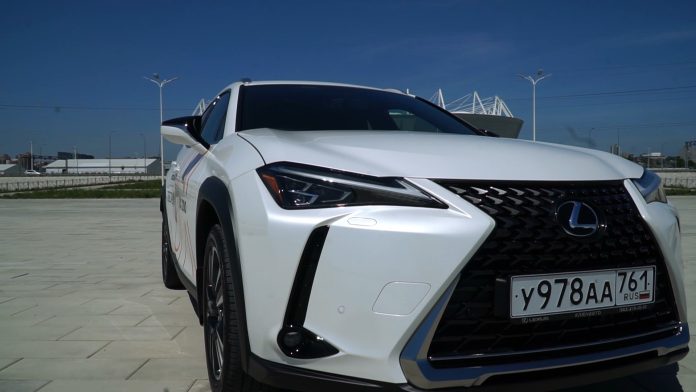The Japanese premium brand’s lineup has almost never had compact models. We’re usually used to thinking of Lexus as something massive and imposing. A big car for big people, but it turns out there’s also a lot of demand in the compact premium segment. The Japanese have prepared the new UX crossover for those who love small but prestigious cars.
The most affordable Lexus
Let’s take a look at the new model from all angles. Lexus has never had anything like this before. Of course, many will argue that there was a hybrid hatchback with the CT index, but that car was more of an image product than a real contender for buyers. And that was a hatchback, but this one, although small, is still a crossover.

Lexus is targeting the compact crossover segment also because the growing number of cars in the world and traffic jams will make getting around in a small car, especially in urban areas, much easier. This is where the model name UX comes from. These two letters stand for Urban Explorer. Essentially, the new Lexus is a compact crossover for city dwellers who value not only maneuverability, but are also not indifferent to their image. Moreover, Lexus decided to appeal to a younger audience, especially the female half, with the new car. Some might say that Lexus has a small NX model – that’s also true, but the Japanese decided to give their customers a choice and introduced another compact new model. More models mean more interest and a wider audience. It will also be the most affordable car in the Lexus lineup.

Exterior
Needless to say, the new model’s appearance is striking. Looking at the Urban Explorer head-on, it bears a striking resemblance to its older brother, the RX—the same stylish grille, sloping hood, and sharp boomerangs of LED headlights. Visually, the car appears larger than it actually is. An inexperienced passerby is unlikely to realize at first glance that it’s a Lexus UX and not the larger RX. It’s like a smaller version. You can tell it’s not an RX from the rear, and not by the badge, but by the distinctive taillights, which are connected by an LED crossbar. Since Lexus is Toyota’s premium brand, the UX is based on a Toyota compact crossover. But unlike Toyota, Lexus has a more aristocratic and serious appearance.

Inside
When you get behind the wheel, you immediately notice the complex interior architecture. The ergonomics are simple and straightforward in typical Toyota style, but still fall short of German refinement. The instrument panel is LCD with a centrally located speedometer. Lately, all the premium brands have started dabbling in electronics, although, personally, to me, analog instrument dials feel more solid in cars of this level.

It’s like an expensive watch, versus the smartwatches that are hyped everywhere now. Speaking of watches, the designers stuck an analog clock on the center panel. It looks weird. Lexus engineers, either give us electronic dials everywhere, or do everything in the classical traditions. Another disappointment that arose from the car was the simple multimedia system with schematic graphics. It doesn’t have the huge screens of the new-generation Mercedes-Benz GLA, which the UX competes with.

The menu controls are traditional for Lexus—a touchpad between the driver and passenger seats. If you’ve driven a Lexus before, you’ll find it difficult to use; if not, you’ll have to get used to it. Although it’s unclear why they couldn’t use a touchscreen like those found in modern smartphones. The standard seats have a decent profile and a good range of adjustments. The top-of-the-line trims feature soft, comfortable leather upholstery, but the base model comes with fabric upholstery, which is quite unusual for a car in this class.

The back seat offers the same amount of space as a regular hatchback, which is understandable—this isn’t a car for a potbellied, slouchy MP or bureaucrat. The crossover isn’t designed for families either, but rather for wealthy, independent young people. The trunk is another weak point of the UX. It’s more like an extension of a woman’s handbag than a proper luggage compartment. It is very small, there is a small underground space, but there is no spare tire. The crossover is equipped with run-flat tires, their design allows you to steer even with a flat tire to a tire shop.
Technology
Our car is equipped with a two-liter gasoline engine with a power of 150 horsepower and front-wheel drive. In European markets and in the USA, the same engine produces 170 horsepower, but in our country it was cut to suit a lower vehicle tax rate. The second engine option is also a two-liter four, but it is paired with a hybrid engine. Hybrid versions are equipped only with all-wheel drive. And here it is not a simple one. E-Four all-wheel drive is an electric motor built into the rear differential. The nickel-metal hydride battery is located in front of the rear axle. The electric motors produce 35 hp. The hybrid UX does not charge from a socket, only while driving. The crossover with a hybrid powertrain produces 178 horsepower. A continuously variable transmission works in tandem with both engines.

On the move
Well, it’s time to try the car in action. The smallest Lexus handles well. It has an adaptive suspension with electronically controlled shock absorbers and the lowest center of gravity in its class. You can customize the suspension. The AVS system can make it sporty stiff or extremely comfortable. The difference between the Comfort and Sport modes is not that significant, but you can feel it. At the same time, the UX is definitely a city dweller. All-wheel drive versions with protective plastic body kit hint at our UX’s crossover roots. Our little guy has 160 mm of ground clearance. However, it’s definitely not recommended for driving in the mud.

Ground clearance and all-wheel drive will only help you if you want to hop a low curb in the city or climb a hill on a slippery road. According to the documentation, the all-wheel drive hybrid UX accelerates to 60 mph in 8.5 seconds. Our purely gasoline UX accelerates to 60 mph in 9.2 seconds. Of course, it’s not a sports car, but at a casual level, you certainly won’t notice this difference in acceleration. The dynamics are sufficient both in the city and on the highway, but when making long overtakes, you have to get used to the CVT operation. At speeds above 70 km/h, the steering becomes heavier, warning you against abrupt maneuvers. By and large, the Lexus UX is a good alternative to premium golf-class hatchbacks.
What we are offered and how much does it all cost
In the base configuration, you will pay mainly for the brand. So, the minimum Lexus UX will not have leather seats, a 360-degree camera, door closers, electric seats and a rear trunk lid, but it will have LED headlights, 17-inch alloy wheels, dual-zone climate control, a tire pressure monitoring system, cruise control, and multimedia. The top-of-the-line Luxury trim will include, for example, a surround-view camera, leather upholstery, power seats, a head-up display, a power tailgate, a huge multimedia display, as well as navigation and active safety systems (lane keeping, automatic braking, and others), but the price difference will almost double.

For example, the base price of the Lexus UX starts at 2,316,000 rubles for a car with a cloth interior and front-wheel drive. Our test car with a two-liter engine, leather interior, and black roof trim costs 2.9 million, but the hybrid version with the F-Sport body kit already jumps over the four million ruble mark. For such a small crossover – it’s a bit pricey. For comparison, its base classmates Mercedes-Benz GLA costs from 2,210,000 rubles, and Audi Q3 1,985,000 rubles, which is noticeably cheaper than our hero.
LEXUS KLYUCHAVTO
Aksaysky Prospekt, 13, Aksay (M4-Don highway)
Phone+7 863 210‑50-50
Website









